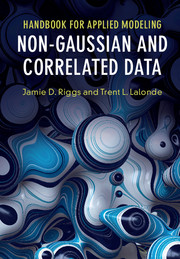Book contents
- Frontmatter
- Dedication
- Contents
- Preface
- 1 The Data Sets
- 2 The Model-Building Process
- 3 Constant Variance Response Models
- 4 Nonconstant Variance Response Models
- 5 Discrete, Categorical Response Models
- 6 Count Response Models
- 7 Time-to-Event Response Models
- 8 Longitudinal Response Models
- 9 Structural Equation Modeling
- 10 Matching Data to Models
- Bibliography
- Index
6 - Count Response Models
Published online by Cambridge University Press: 03 August 2017
- Frontmatter
- Dedication
- Contents
- Preface
- 1 The Data Sets
- 2 The Model-Building Process
- 3 Constant Variance Response Models
- 4 Nonconstant Variance Response Models
- 5 Discrete, Categorical Response Models
- 6 Count Response Models
- 7 Time-to-Event Response Models
- 8 Longitudinal Response Models
- 9 Structural Equation Modeling
- 10 Matching Data to Models
- Bibliography
- Index
Summary
Introduction
Counting in one form or another likely predates written human history. In modern society, counting is ubiquitous in many aspects of individual and collective human lives. One often-asked question of an individual is how many children are in his or her family. School systems are concerned with the related question of how many children are in a class or in an entire district, though the range of the counts in these cases is usually entirely different. A characteristic common to all counting systems is that counts are never less than zero, and some of these systems have maxima that may be treated as infinite: e.g., the number of grains of sand on all the beaches of the Earth, or the number stars in the observable universe. Some finite counting examples are the number of defects on an airplane, the number of radioactive decay products in a particle accelerator collision, or the number of students eligible for graduation term by term. Sports are teeming with examples of counting including the score from a round of golf, baseball's runs batted-in (RBI), and the number of goals averted in football. These examples demonstrate that count data permeate everyday human life.
The counting examples above suggest that count data have different types. The number of children in a nuclear family may be considered a tightly restricted range from zero to, say, twenty. However, the number of children in a school class is never zero. Batters on a baseball team may have a large number of players with no (zero) RBIs. The day-to-day sales of automobiles may range from zero and upwards based on a popular probability distribution such as the Poisson probability distribution or the negative binomial probability distribution. Count data statistical models rely on the probability distribution chosen for the parameter estimation method and reliability of the analysis outcomes.
Regardless of which probability distribution model is used to describe count data, one critical property of each model is that the counts are not transformed to approximate a normal distribution to allow the use of ordinary least squares estimation. Rather, the count distribution mean and variance are used to establish a nonlinear model link between the count response and the selected predictors.
- Type
- Chapter
- Information
- Handbook for Applied Modeling: Non-Gaussian and Correlated Data , pp. 108 - 131Publisher: Cambridge University PressPrint publication year: 2017



